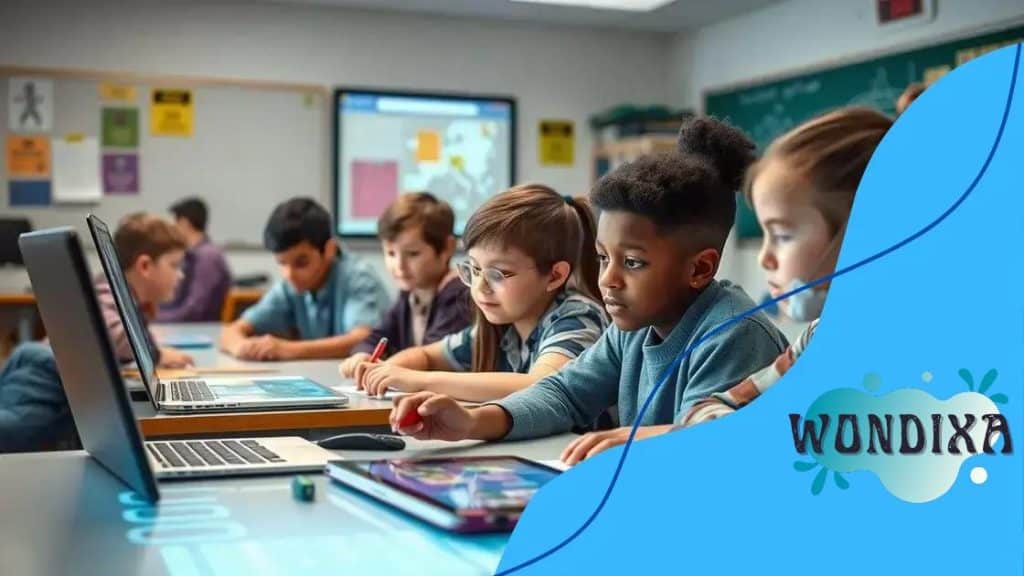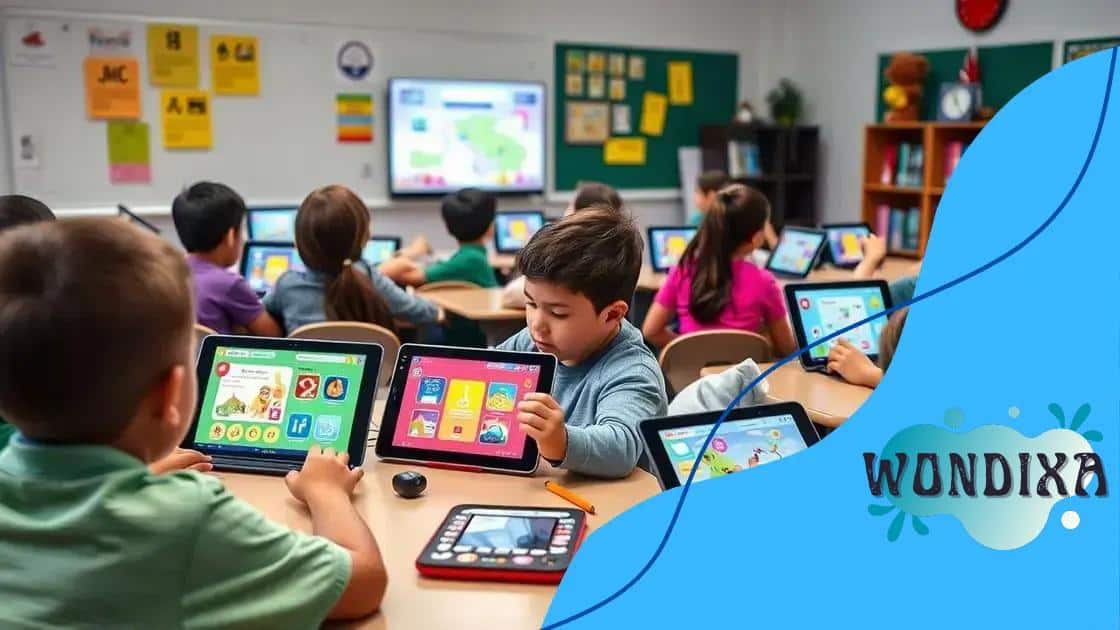Gamified learning platforms for K-12 students: revolutionizing education

Gamified learning platforms for K-12 students enhance engagement and motivation by incorporating game elements into education, though challenges like technical issues and the need for balancing education with entertainment exist.
Gamified learning platforms for K-12 students are changing the way kids learn by making education more enjoyable. Have you ever wondered how games can unlock students’ potential? This article delves into the exciting world of educational games and their impact.
Understanding gamified learning platforms
Understanding gamified learning platforms is key to embracing modern education methods. These platforms blend learning and play, creating an engaging environment for students.
Gamified learning uses game design elements to motivate students. By incorporating challenges, points, and rewards, it makes subjects more appealing. Let’s explore how these platforms work.
How gamified learning works
Gamified systems encourage participation by turning lessons into interactive quests. Students earn points for completing tasks, similar to leveling up in a video game. This approach rewards their hard work and boosts confidence.
Benefits of gamified learning
- Increased engagement: Students are more likely to participate actively when learning feels like a game.
- Improved retention: Fun activities help in remembering information longer.
- Instant feedback: Gamified platforms often provide immediate results, allowing students to learn from mistakes right away.
- Enhanced teamwork: Many platforms encourage collaboration, building strong communication skills among peers.
Furthermore, using these platforms can lead to better performance in academics. Since students enjoy learning, they tend to focus more and achieve higher grades. It’s essential to choose the right platform that aligns with your educational goals.
In summary, gamified learning platforms are transforming K-12 education by making learning fun and accessible. By understanding their mechanics and benefits, educators can effectively implement these tools to enhance student outcomes.
Benefits of gamified learning for K-12 students
The benefits of gamified learning for K-12 students are significant and multifaceted. By integrating game elements into educational activities, these platforms can turn learning into an engaging and enjoyable experience.
One of the primary advantages is increased motivation. When students see their progress through points and rewards, they are more inspired to participate actively. This drive helps them to tackle challenging subjects with enthusiasm.
Academic Performance
Gamification can lead to improved academic performance. As students engage more with the content, they tend to retain information better. The interactive nature of gamified learning encourages deeper understanding, making it easier for students to grasp complex concepts.
Skill Development
- Critical thinking: Gamified tasks often require problem-solving, enhancing students’ analytical skills.
- Collaboration: Many games promote teamwork, helping students learn to communicate and cooperate effectively.
- Resilience: Through challenges in games, students learn to persevere, which is essential in both academics and life.
- Time management: Balancing different tasks in a game encourages students to manage their time efficiently.
Additionally, gamified platforms often provide instant feedback. This helps students identify areas for improvement and adapt their learning strategies accordingly. The fun factor involved in gamified learning reduces anxiety around assessments, making learning a more positive experience.
Ultimately, gamified learning fosters not only knowledge acquisition but also the development of essential life skills. By creating a vibrant learning environment, educational institutions can significantly enhance students’ overall learning experiences.
Top platforms for gamified learning

Exploring the top platforms for gamified learning can help educators choose the right tools for their classrooms. These platforms combine fun and education, making learning exciting for K-12 students.
Some of the best options available today cater to various needs and learning styles. Let’s take a closer look at a few standout platforms that have gained popularity among teachers and students alike.
Kahoot!
Kahoot! is a game-based learning platform that allows teachers to create quizzes and games. Students can answer questions using their devices, and they earn points for speed and accuracy. This platform fosters friendly competition and encourages engagement, making learning feel like a fun game.
Classcraft
Classcraft turns education into an adventure. By creating characters and completing quests, students learn subjects while collaborating with peers. This platform emphasizes teamwork, communication, and problem-solving skills.
Quizizz
Quizizz offers a quiz-based structure that allows for both synchronous and asynchronous play. Unlike traditional quizzes, students enjoy a game-like experience that promotes motivation and confidence. They can compete against classmates or work at their own pace.
Prodigy Math
Prodigy Math is an interactive math platform designed for students in grades 1-8. It combines math practice with a fantasy game, allowing students to earn rewards as they progress. The adaptive nature of the platform provides personalized learning experiences tailored to each student’s abilities.
- Engagement: These platforms make learning an engaging and enjoyable experience.
- Accessibility: Many offer resources that cater to diverse learners.
- User-friendly: Simple interfaces allow for easy navigation without needing extensive training.
- Community: Many platforms have vibrant communities where teachers can share resources and strategies.
Choosing the right platform can make a significant difference in how students engage with their education. By using these gamified learning tools, educators can create a dynamic classroom environment that motivates and inspires students.
How to integrate gamified learning in classrooms
Integrating gamified learning in classrooms can transform the educational experience for both teachers and students. This approach encourages engagement and motivation, making lessons more interactive.
To get started, educators should begin by selecting appropriate gamified platforms that align with their teaching goals. It’s essential to find tools that cater to the specific needs of the students. When platforms are relevant, they can greatly enhance the learning experience.
Steps to Integration
First, teachers should familiarize themselves with the selected platform. Taking time to understand its features allows for smoother implementation. Once comfortable, it’s time to introduce the platform to students. Begin with a simple game or quiz to demonstrate its functionality. This can spark interest and excitement.
Engagement Techniques
To further engage students, consider these strategies:
- Establish clear goals: Explain what students need to achieve and how they can earn rewards.
- Encourage collaboration: Group projects can lead to teamwork and communication, which are vital skills.
- Set a routine: Regularly incorporating gamified elements into lessons helps establish comfort and familiarity.
- Celebrate achievements: Recognize students’ successes, big and small, to boost their confidence and motivation.
Another effective approach is to blend traditional instruction with gamification. Teachers can introduce a lesson, then transition into a gamified activity that reinforces the concepts taught. This combination keeps students engaged and makes learning feel less like a chore.
Regular feedback is crucial in this process. Using gamified platforms allows for immediate responses, helping students understand their progress. Teachers should monitor their students’ performance closely and adjust activities to ensure all learners are challenged appropriately.
Ultimately, incorporating gamified learning in classrooms not only enhances education but also fosters a positive learning environment. By implementing these strategies, educators can create a dynamic, fun, and effective educational experience for their students.
Challenges of using gamified platforms in education
While gamified platforms can enhance learning, there are several challenges of using gamified platforms in education that educators must consider. Understanding these hurdles is crucial for successful implementation.
One significant challenge is the initial learning curve for both students and teachers. Not everyone is familiar with gamification, and it may take time to adapt to new technology. Educators might need to invest time in training, which can be difficult amidst busy schedules.
Technical Issues
Technical problems can also arise. Internet connectivity issues or software glitches can disrupt lessons, leading to frustration. Such interruptions may cause students to lose interest and disengage with the material.
Balancing Game Mechanics
Another challenge involves balancing game mechanics with educational goals. If the emphasis shifts too much towards competition, some students might feel discouraged. It’s essential to ensure that gamification enhances learning rather than detracts from it.
- Equity: Some students may not have the same access to technology at home, creating disparities.
- Over-reliance: Students may become overly reliant on game mechanics for motivation, which can hinder intrinsic motivation.
- Content alignment: Not all subjects readily adapt to gamified learning, making it hard for teachers to find suitable platforms.
- Feedback overload: With instant feedback, some students may feel overwhelmed and anxious about performance.
Additionally, teachers need to continually assess the effectiveness of the platforms. While games can engage, they must also meet educational standards and deliver clear learning outcomes.
To address these challenges, it’s helpful for educators to collaborate and share strategies that have worked in their classrooms. Building a community can lend support and provide new ideas to overcome obstacles.
FAQ – Frequently Asked Questions about Gamified Learning Platforms
What are gamified learning platforms?
Gamified learning platforms use game elements, such as points and rewards, to make learning more engaging and fun for students.
What are the benefits of using gamified learning in classrooms?
Benefits include increased student engagement, improved motivation, and enhanced retention of information through interactive activities.
What challenges might educators face when implementing gamified learning?
Challenges include technical issues, the need for teacher training, balancing educational content with game mechanics, and potential disparities in technology access.
How can teachers effectively integrate gamified learning into their lessons?
Teachers can start by selecting suitable platforms, providing training, setting clear goals, and regularly assessing student progress to ensure effective learning.





